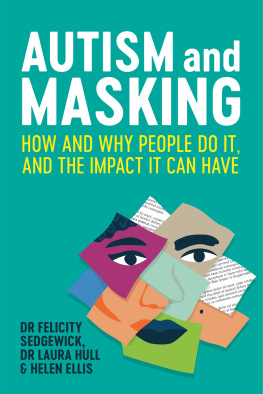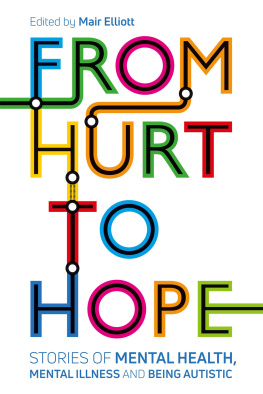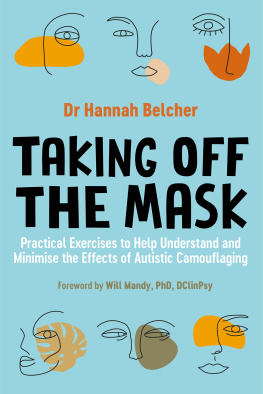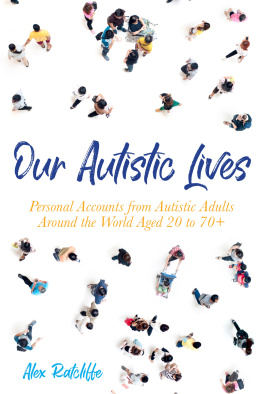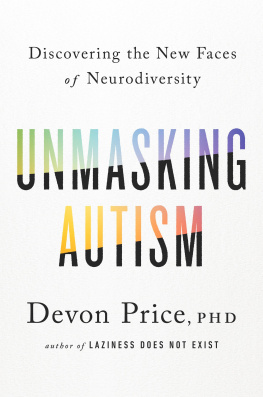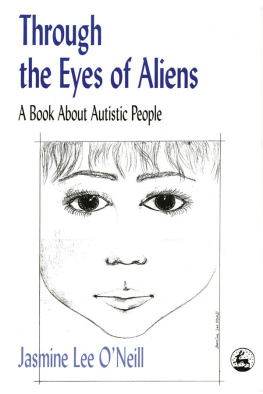Contents
- Is it just caring what people think of you?
Reputation management
- Guidance for partners/spouses and children
(autistic and non-autistic)
Page list

of related interest
Camouflage
The Hidden Lives of Autistic Women
Dr Sarah Bargiela
Illustrated by Sophie Standing
ISBN 978 1 78592 566 5
e ISBN 978 1 78592 667 9
Working with Girls and Young Women with an Autism Spectrum Condition
A Practical Guide for Clinicians
Fiona Fisher Bullivant
ISBN 978 1 78592 420 0
e ISBN 978 1 78450 784 8
Girls with Autism Becoming Women
Heather Stone Wodis
Foreword by Erika Hammerschmidt
ISBN 978 1 78592 818 5
e ISBN 978 1 78450 907 1
Spectrum Women
Walking to the Beat of Autism
Edited by Barb Cook and Dr Michelle Garnett
Foreword by Lisa Morgan
ISBN 978 1 78592 434 7
e ISBN 978 1 78450 806 7
Women and Girls with Autism Spectrum Disorder
Understanding Life Experiences from Early Childhood to Old Age
Sarah Hendrickx
ISBN 978 1 84905 547 5
e ISBN 978 0 85700 982 1
Autism and
Masking
How and Why People Do It,
and the Impact It Can Have
Dr Felicity Sedgewick,
Dr Laura Hull and Helen Ellis

First published in Great Britain in 2022 by Jessica Kingsley Publishers
An Hachette Company
Copyright Felicity Sedgewick, Laura Hull and Helen Ellis 2022
The rights of Felicity Sedgewick, Laura Hull and Helen Ellis to be identified as the Authors of the Work has been asserted by them in accordance with the Copyright, Designs and Patents Act 1988.
Front cover image source: Shutterstock.
All rights reserved. No part of this publication may be reproduced, stored in a retrieval system, or transmitted, in any form or by any means without the prior written permission of the publisher, nor be otherwise circulated in any form of binding or cover other than that in which it is published and without a similar condition being imposed on the subsequent purchaser.
A CIP catalogue record for this title is available from the British Library and the Library of Congress
ISBN 978 1 78775 579 6
e ISBN 978 1 78775 580 2
Jessica Kingsley Publishers policy is to use papers that are natural, renewable and recyclable products and made from wood grown in sustainable forests. The logging and manufacturing processes are expected to conform to the environmental regulations of the country of origin.
Jessica Kingsley Publishers
Carmelite House
50 Victoria Embankment
London EC4Y 0DZ
www.jkp.com
Contents
Is it just caring what people think of you?
Reputation management
Guidance for partners/spouses and children
(autistic and non-autistic)
Acknowledgements
There have been an immeasurable number of people to whom we owe thanks for their part in this book coming together: our contributors and the multitude of autistic people who have taken part in the research we cite have given their time and personal experiences to move autism knowledge forwards; our employers, who have been understanding of us taking time to work on this totally separate project outside our paid roles; and, of course, the team at Jessica Kingsley Publishers who have shared their expertise and insights with us, making this book better than it would ever have been without them.
We also have some people we would like to acknowledge individually:
Felicity: Writing and editing this book has been an experience mostly a good one. For support during the times that it was not so good, I want to thank my parents, who have listened to me sketch out ideas and complain about tricky sections on far too many phone calls. To my co-authors who have made this a much more interesting and enjoyable process than it could ever have been doing it on my own we have earned a celebration together, having done the entire thing through virtual communication! For the insights shared, I want to thank the autistic people in my life both personally and professionally. You have made this book possible, and it is an honour to share your stories and experiences with the world. Finally, I owe heartfelt thanks to my partner, who has kept me going throughout, known when to drag me away from the computer screen, was an excellent sounding board for ideas and generally improves my life hugely.
Laura: I am so grateful to have been able to contribute to this book which involves reflecting on my entire academic career so far and trying to improve upon the parts I wish I had done differently! Thanks to Felicity and Helen for making the whole experience truly enjoyable and collaborative, despite taking place during a global pandemic. I want to thank my colleagues at UCL, my friends and my family; in particular my partner Max, for listening to my enthusiastic summaries and motivating me with hot chocolate during those late-night writing sessions. And finally, thanks to everyone who has shared their insights on masking with me, whether directly or indirectly, through research, collaboration, or just on Twitter. All interesting and useful opinions in this book are thanks to you; any misinterpretations are my own.
Helen: This book has been a true labour of love; its been emotionally draining to be so open and exposed about something that impacts so much of my life. My sincere thanks to my co-authors for taking my rambling personal explanations and pseudo-therapy sessions and shaping them into something that we hope will be useful to autistic people, family members and professionals across all fields! Im also grateful to my employers, the National Autistic Society, who have supported me in writing this book independently of my job. Its not easy knowing where work me finishes and autistic individual me starts sometimes, but we seem to manage it okay mostly! To the Wolfpack and my Tribe thank you for being the joy in my life. And finally, my everlasting gratitude to my family you have each played such key parts in helping me to find the ways to feel like I can lower my various masks and be myself, and indeed give me the confidence to share the hard-won wisdom I have earned, whatever it takes.
Preface
It is always good to know a little about the people who wrote a book as you read it, so each of the authors has written a short introduction to themselves and how they came to be involved in this project.
Felicity Sedgewick
I am an academic whose work focuses on the overlap between social and developmental psychology, rather than sitting in one specialism. I am non-autistic, though I have friends, family members and colleagues who represent a range of neurodiverse conditions, and have done my entire life. I have carried out research into gender differences in autism, autism and relationships, and autism and mental health, as well as how these areas all interact. Although rarely the focus of these projects, camouflaging has been a common theme in nearly every study I have done, as it has such an impact on relationships and mental health and because it is used differently by people of different genders. Understanding the impact of theorized constructs (such as camouflaging/masking) on the everyday lives of autistic people is central to all my interests. I care deeply about sharing that knowledge with those who are best placed to use it to improve autistic peoples lives, and do a lot of outreach work to try to make this happen. I see this book as the next part of that passion project, and am excited about the chance for more people to learn about masking among autistic people.

